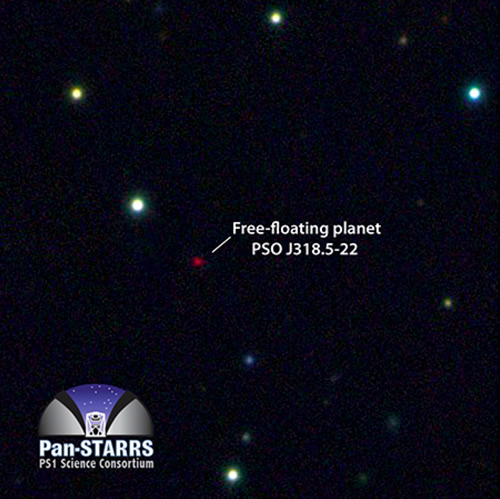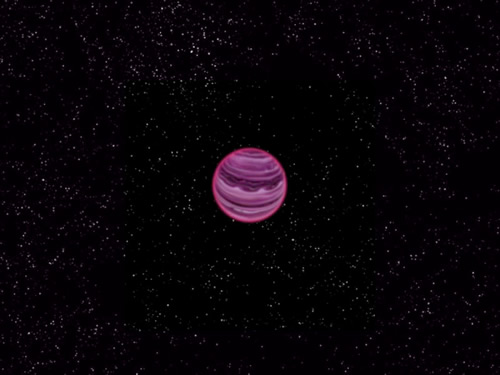
About 80 light years from Earth is a lonely planet. Its name is "PSO J318.5-22" and it was discovered by an international team of astronomers during a wide field survey. The little guy is about six times the size of Jupiter, with all the properties of a gas giant, and probably formed just a short 12 million years ago, making it a relatively young planet.
Thanks to the extreme sensitivity of the Pan-STARRS 1 (PS1) wide-field telescope on Haleakala, Maui, the unique heat signature of the newborn planet stood out against a massive field of data. This prompted astronomers to do follow-up observations - observations which show that PSO J318.5-22 is all by itself, drifting in space - with no host star or orbit to speak of.

The Lonely Planet. Credit: N. Metcalfe & Pan-STARRS 1 Science Consortium
"We have never before seen an object free-floating in space that looks like this," said team leader Dr. Michael Liu of the Institute for Astronomy at the University of Hawaii at Manoa. "It has all the characteristics of young planets found around other stars, but it is drifting out there all alone. I had often wondered if such solitary objects exist, and now we know they do."
But finding undiscovered planets isn't exactly hot news. For the last ten years researchers have been swatting extrasolar orbs out of the starry sky like mosquitoes before moonrise.
Through techniques like the transit method and measuring stellar wobble, astronomers have identified about a thousand new worlds; yet only a very tiny few have been directly imaged.
What all of these alien worlds have in common is a parent star: a young star of less than 200 million years old. What makes PSO J318.5-22 so unique is its resemblance to these other planets in respect to energy output, color and size. The one exception is that it is probably the lowest-mass free-floating object known. "Planets found by direct imaging are incredibly hard to study, since they are right next to their much brighter host stars," said Dr. Niall Deacon of the Max Planck Institute for Astronomy in Germany and a co-author of the study. "PSO J318.5-22 is not orbiting a star so it will be much easier for us to study. It is going to provide a wonderful view into the inner workings of gas-giant planets like Jupiter shortly after their birth."
The lonely planet was discovered during a search for failed stars, more commonly known as brown dwarfs. Because of their "cool" nature, these not-quite stars are intrinsically faint and emit a red signature. Through the use of the PS1 telescope, Liu and the research team were able to accumulate images taken with a camera sensitive enough to pick up the red signature of a brown dwarf.
To the eye of the camera, PSO J318.5-22 stood out against the information like a solitary ruby. To give you an idea of how much data needs to be sorted through to find just one blip on the proverbial planetary radar, imagine the equivalent of 60,000 iPhone photos taken every night for 730 nights. The total dataset to date is about 4,000 terabytes. That digital sum equates to even more than all the movies ever made, all the books ever published and all the music albums ever released!
"We often describe looking for rare celestial objects as akin to searching for a needle in a haystack," said Dr. Eugene Magnier of the Institute for Astronomy at the University of Hawaii at Manoa and a co-author of the study. "So we decided to search the biggest haystack that exists in astronomy, the dataset from PS1."

Artist's conception of PSO J318.5-22. (Credit: MPIA/V. Ch. Quetz)
However, this wasn't a one night stand. Not only did the team follow up the PS1 discovery with several other telescopes at Mauna Kea, they regularly monitored the position of PSO J318.5-22 over two years with the Canada-France-Hawaii Telescope.
The lonesome planet was imaged in the infrared with the NASA Infrared Telescope Facility, and the Gemini North Telescope verified that it was not a brown dwarf in disguise. It's a planet alright. One that belongs to a young collection of stars known as the Beta Pictoris Moving Group, because of its location within the boundary of the group. But while it shares the same proper motion as the moving group, the mysterious new planet is moving around on its own!


















